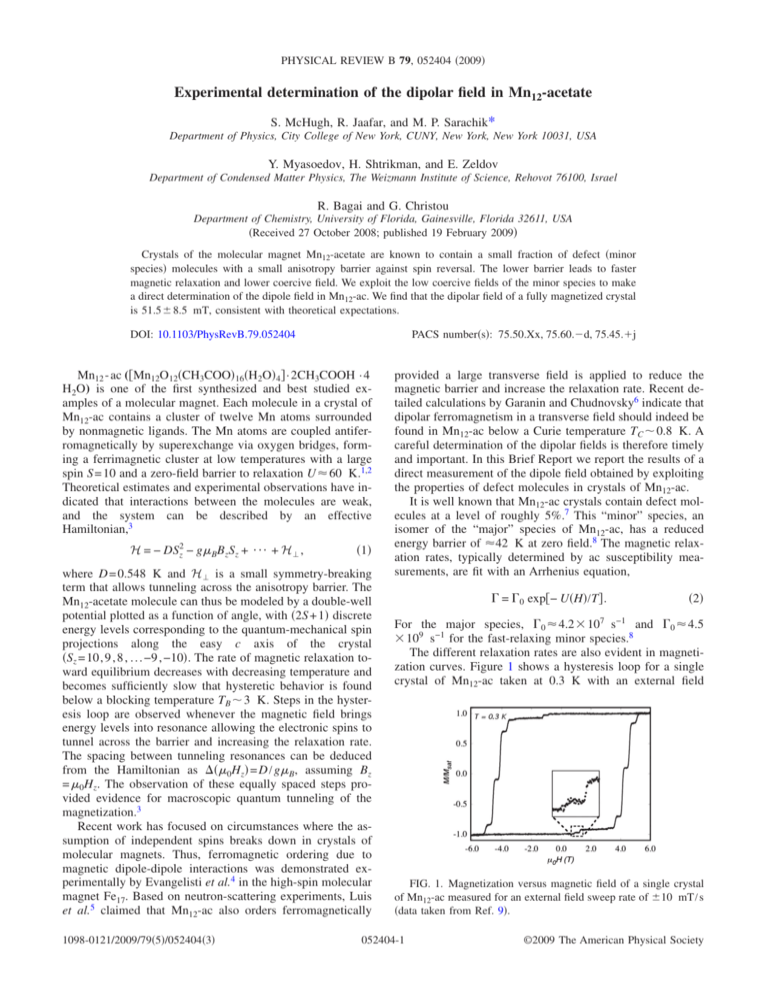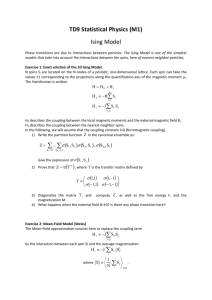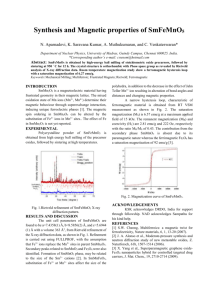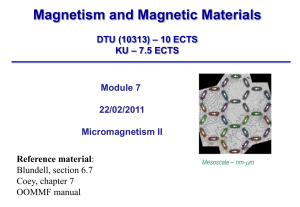Phys. Rev. B 79, 052404 - Weizmann Institute of Science
advertisement

PHYSICAL REVIEW B 79, 052404 共2009兲 Experimental determination of the dipolar field in Mn12-acetate S. McHugh, R. Jaafar, and M. P. Sarachik* Department of Physics, City College of New York, CUNY, New York, New York 10031, USA Y. Myasoedov, H. Shtrikman, and E. Zeldov Department of Condensed Matter Physics, The Weizmann Institute of Science, Rehovot 76100, Israel R. Bagai and G. Christou Department of Chemistry, University of Florida, Gainesville, Florida 32611, USA 共Received 27 October 2008; published 19 February 2009兲 Crystals of the molecular magnet Mn12-acetate are known to contain a small fraction of defect 共minor species兲 molecules with a small anisotropy barrier against spin reversal. The lower barrier leads to faster magnetic relaxation and lower coercive field. We exploit the low coercive fields of the minor species to make a direct determination of the dipole field in Mn12-ac. We find that the dipolar field of a fully magnetized crystal is 51.5⫾ 8.5 mT, consistent with theoretical expectations. DOI: 10.1103/PhysRevB.79.052404 PACS number共s兲: 75.50.Xx, 75.60.⫺d, 75.45.⫹j Mn12 - ac (关Mn12O12共CH3COO兲16共H2O兲4兴 · 2CH3COOH · 4 H2O) is one of the first synthesized and best studied examples of a molecular magnet. Each molecule in a crystal of Mn12-ac contains a cluster of twelve Mn atoms surrounded by nonmagnetic ligands. The Mn atoms are coupled antiferromagnetically by superexchange via oxygen bridges, forming a ferrimagnetic cluster at low temperatures with a large spin S = 10 and a zero-field barrier to relaxation U ⬇ 60 K.1,2 Theoretical estimates and experimental observations have indicated that interactions between the molecules are weak, and the system can be described by an effective Hamiltonian,3 H = − DSz2 − gBBzSz + ¯ + H⬜ , 共1兲 where D = 0.548 K and H⬜ is a small symmetry-breaking term that allows tunneling across the anisotropy barrier. The Mn12-acetate molecule can thus be modeled by a double-well potential plotted as a function of angle, with 共2S + 1兲 discrete energy levels corresponding to the quantum-mechanical spin projections along the easy c axis of the crystal 共Sz = 10, 9 , 8 , . . . −9 , −10兲. The rate of magnetic relaxation toward equilibrium decreases with decreasing temperature and becomes sufficiently slow that hysteretic behavior is found below a blocking temperature TB ⬃ 3 K. Steps in the hysteresis loop are observed whenever the magnetic field brings energy levels into resonance allowing the electronic spins to tunnel across the barrier and increasing the relaxation rate. The spacing between tunneling resonances can be deduced from the Hamiltonian as ⌬共0Hz兲 = D / gB, assuming Bz = 0Hz. The observation of these equally spaced steps provided evidence for macroscopic quantum tunneling of the magnetization.3 Recent work has focused on circumstances where the assumption of independent spins breaks down in crystals of molecular magnets. Thus, ferromagnetic ordering due to magnetic dipole-dipole interactions was demonstrated experimentally by Evangelisti et al.4 in the high-spin molecular magnet Fe17. Based on neutron-scattering experiments, Luis et al.5 claimed that Mn12-ac also orders ferromagnetically 1098-0121/2009/79共5兲/052404共3兲 provided a large transverse field is applied to reduce the magnetic barrier and increase the relaxation rate. Recent detailed calculations by Garanin and Chudnovsky6 indicate that dipolar ferromagnetism in a transverse field should indeed be found in Mn12-ac below a Curie temperature TC ⬃ 0.8 K. A careful determination of the dipolar fields is therefore timely and important. In this Brief Report we report the results of a direct measurement of the dipole field obtained by exploiting the properties of defect molecules in crystals of Mn12-ac. It is well known that Mn12-ac crystals contain defect molecules at a level of roughly 5%.7 This “minor” species, an isomer of the “major” species of Mn12-ac, has a reduced energy barrier of ⬇42 K at zero field.8 The magnetic relaxation rates, typically determined by ac susceptibility measurements, are fit with an Arrhenius equation, ⌫ = ⌫0 exp关− U共H兲/T兴. 共2兲 For the major species, ⌫0 ⬇ 4.2⫻ 107 s−1 and ⌫0 ⬇ 4.5 ⫻ 109 s−1 for the fast-relaxing minor species.8 The different relaxation rates are also evident in magnetization curves. Figure 1 shows a hysteresis loop for a single crystal of Mn12-ac taken at 0.3 K with an external field FIG. 1. Magnetization versus magnetic field of a single crystal of Mn12-ac measured for an external field sweep rate of ⫾10 mT/ s 共data taken from Ref. 9兲. 052404-1 ©2009 The American Physical Society PHYSICAL REVIEW B 79, 052404 共2009兲 BRIEF REPORTS FIG. 2. 共Color online兲 Schematic of the procedure used to prepare Mn12-ac with minor and major species magnetized in opposite directions. 共a兲 First, a +6 T field is applied to align all spins. 共b兲 Then, a −2 T field is applied, reversing the magnetization of the minor species. 共c兲 Finally, the field is returned to zero, leaving the major and minor species spins antiparallel. sweep rate of ⫾10 mT/ s 共data taken from Ref. 9兲. Starting from zero field, the total magnetization is constant as the field is increased to 0.90 T. Small steps are observed at 0.9 and 1.28 T corresponding to the resonant relaxation of the minor species magnetization. Above 1.5 T, all minor species molecules have reversed and no further change in the total magnetization is seen until ⬇3 T. Between 3.1 and 5.3 T, evenly spaced steps are observed due to tunneling of the major species. Above 5.3 T, all the major species molecules have reversed and the crystal is completely magnetized. Using a simple protocol similar to one described in Ref. 10, the difference in the fields required to flip the spins of the major and minor species allows one to magnetically prepare the crystal with 共A兲 minor species aligned and major species spins random; 共B兲 major and minor species spins aligned in the same direction; and 共C兲 major and minor species spins aligned in opposite directions. 共A兲 Starting with an unmagnetized 共zero-field-cooled兲 crystal and maintaining the temperature at 300 mK, a magnetic field of −2 T is applied which is sufficient to completely magnetize the minor species while leaving the major species spins unchanged; sweeping the field back to zero yields a sample with minor species spins aligned and major species spins random with zero net magnetization of the latter species. 共B兲 A larger magnetic field of −6.0 T is applied along the c axis of the crystal, sufficient to magnetize both species; reducing the magnetic field to zero yields a sample with major species and minor species spins aligned in the same direction. 共C兲 This magnetic preparation is described schematically in Fig. 2. Starting with the spins aligned in the same direction 关Fig. 2共a兲兴, the magnetic field is ramped to −2 T in the direction opposite to the magnetization, reversing the direction of the minor species spins while leaving the major species spins unchanged, as shown in Fig. 2共b兲. Reducing the field back to zero 关Fig. 2共c兲兴 yields a sample in which the minor and major species are magnetized in opposite directions. With the sample prepared according to these three methods, we measured the hysteresis loop of the minor species by sweeping the magnetic field between +2 and −2 T, taking care not to reach fields large enough to reverse the spins of the major species. The magnetization was measured using an array of micron-sized Hall sensors for a single crystal of Mn12-ac with dimensions of 1.0⫻ 0.3⫻ 0.3 mm3 immersed FIG. 3. 共Color online兲 共a兲 Magnetization of the minor species as a function of external magnetic field swept at +5 mT/ s with the major species magnetization prepared following the three protocols described in the text. The triangles 共squares兲 are data taken with the major species aligned in the positive 共negative兲 direction. The circles are data taken with the major species randomly oriented to yield zero magnetization. 共b兲 The derivative of the curves shown in frame 共a兲. The dashed lines are drawn as guides to the eyes. in 3He. The measurements were repeated on single crystals of similar dimensions with similar results. Experimental details can be found in Ref. 11. Figure 3共a兲 shows hysteresis curves for the minor species taken at 0.3 K and an external field sweep rate of 5 mT/s for the three different magnetic preparations. The curves are normalized by M sat, the saturation value of the minor species. The minor species hysteresis curves exhibit a similar staircase structure as the major species. However, the smaller anisotropy leads to a smaller spacing between steps. Figure 3共b兲 shows the derivative of the magnetization curve, which 052404-2 PHYSICAL REVIEW B 79, 052404 共2009兲 BRIEF REPORTS is useful for determining the location and widths of the tunneling resonances. It is clear that the externally applied magnetic field corresponding to the tunneling resonances depends on the direction of the magnetization of the major species. The circles of Fig. 3 are data taken with the net magnetization of the major species equal to zero. Fully magnetizing the major species in the positive direction shifts the location of the tunneling resonance fields by ⬇−0.05 T, as indicated by the triangles. Here the dipolar field adds to the external field to satisfy the resonance condition. The squares are data taken with the major species magnetized fully in the negative direction with a consequent shift in the resonance field of ⬇ + 0.05 T. In this case, the external field is larger to offset the dipolar field in the opposite direction. A close determination of the shift corresponding to the dipolar field associated with full magnetization of the major species of Mn12-ac is obtained from the maxima in Fig. 3共b兲, yielding 51.5⫾ 8.5 mT. The dipolar This work was supported at City College by the NSF under Grant No. DMR-00451605. E.Z. and H.S. acknowledge the support of the Israel Ministry of Science, Culture and Sports. Support for G.C. was provided by the NSF under Grant No. CHE-0414555. 7 *sarachik@sci.ccny.cuny.edu Lis, Acta Crystallogr. B36, 2042 共1980兲. 2 R. Sessoli, D. Gatteschi, A. Caneschi, and M. A. Novak, Nature 共London兲 365, 141 共1993兲. 3 J. R. Friedman, M. P. Sarachik, J. Tejada, and R. Ziolo, Phys. Rev. Lett. 76, 3830 共1996兲; L. Thomas, F. Lionti, R. Ballou, D. Gatteschi, R. Sessoli, and B. Barabara, Nature 共London兲 383, 145 共1996兲. 4 M. Evangelisti, A. Candini, A. Ghirri, M. Affronte, G. W. Powell, I. A. Gass, P. A. Wood, S. Parsons, E. K. Brechin, D. Collison, and S. L. Heath, Phys. Rev. Lett. 97, 167202 共2006兲. 5 F. Luis, J. Campo, J. Gomez, G. J. McIntyre, J. Luzon, and D. Ruiz-Molina, Phys. Rev. Lett. 95, 227202 共2005兲. 6 D. A. Garanin and E. M. Chudnovsky, Phys. Rev. B 78, 174425 共2008兲. 1 T. fields of a completely magnetized crystal of Mn12-ac calculated in Ref. 6 was found to be 52.6 mT, in excellent agreement with our data. It should be noted that a determination of the dipolar field using the observed shifts of the steps in the magnetization of the minor isomeric species relies on the fact that the fraction of the minor species is very low. The results reported here should be treated as a lower bound on the size of the major species dipolar fields. Further support for the results reported in this Brief Report is provided by measurements of magnetic avalanches in Mn12-ac and will be published elsewhere. Z. M. Sun, D. Ruiz, N. R. Dilley, M. Soler, J. Ribas, K. Folting, M. B. Maple, G. Christou, and D. N. Hendrickson, Chem. Commun. 共Cambridge兲 19, 1973 共1999兲; W. Wernsdorfer, R. Sessoli, and D. Gatteschi, Europhys. Lett. 47, 254 共1999兲. 8 M. Soler, W. Wernsdorfer, Z. M. Sun, J. C. Huffman, D. N. Hendrickson, and G. Christou, Chem. Commun. 共Cambridge兲 21, 2672 共2003兲. 9 Y. Suzuki, Ph. D. thesis, CUNY, New York, 2007. 10 W. Wernsdorfer, N. E. Chakov, and G. Christou, arXiv:condmat/0405014 共unpublished兲. 11 Y. Suzuki, M. P. Sarachik, E. M. Chudnovsky, S. McHugh, R. Gonzalez-Rubio, N. Avraham, Y. Myasoedov, E. Zeldov, H. Shtrikman, N. E. Chakov, and G. Christou, Phys. Rev. Lett. 95, 147201 共2005兲. 052404-3






